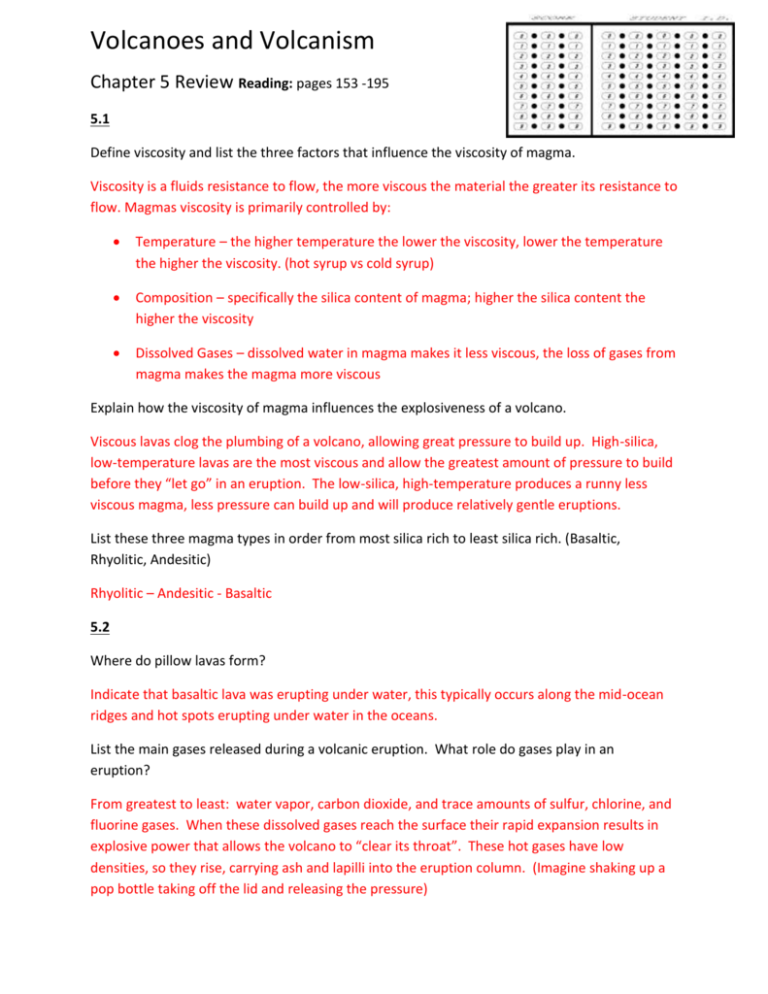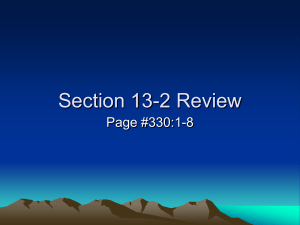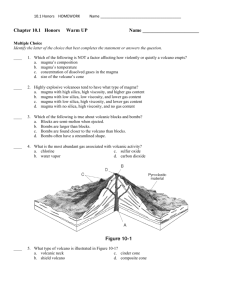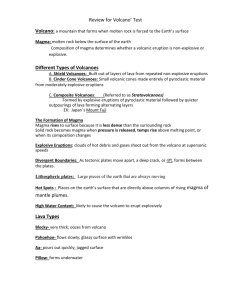Dual Geo Ch 5 Review Questions Ans Key
advertisement

Volcanoes and Volcanism Chapter 5 Review Reading: pages 153 -195 5.1 Define viscosity and list the three factors that influence the viscosity of magma. Viscosity is a fluids resistance to flow, the more viscous the material the greater its resistance to flow. Magmas viscosity is primarily controlled by: Temperature – the higher temperature the lower the viscosity, lower the temperature the higher the viscosity. (hot syrup vs cold syrup) Composition – specifically the silica content of magma; higher the silica content the higher the viscosity Dissolved Gases – dissolved water in magma makes it less viscous, the loss of gases from magma makes the magma more viscous Explain how the viscosity of magma influences the explosiveness of a volcano. Viscous lavas clog the plumbing of a volcano, allowing great pressure to build up. High-silica, low-temperature lavas are the most viscous and allow the greatest amount of pressure to build before they “let go” in an eruption. The low-silica, high-temperature produces a runny less viscous magma, less pressure can build up and will produce relatively gentle eruptions. List these three magma types in order from most silica rich to least silica rich. (Basaltic, Rhyolitic, Andesitic) Rhyolitic – Andesitic - Basaltic 5.2 Where do pillow lavas form? Indicate that basaltic lava was erupting under water, this typically occurs along the mid-ocean ridges and hot spots erupting under water in the oceans. List the main gases released during a volcanic eruption. What role do gases play in an eruption? From greatest to least: water vapor, carbon dioxide, and trace amounts of sulfur, chlorine, and fluorine gases. When these dissolved gases reach the surface their rapid expansion results in explosive power that allows the volcano to “clear its throat”. These hot gases have low densities, so they rise, carrying ash and lapilli into the eruption column. (Imagine shaking up a pop bottle taking off the lid and releasing the pressure) Volcanoes and Volcanism Chapter 5 Review Reading: pages 153 -195 List and describe the types of pyroclastic materials (tephra). Listed from smallest to largest: Ash, lapilli, block and bombs depending on if the material left the volcano as a solid or liquid fragment. How does scoria differ from pumice? Both of these are a result of bubbles of gas not popping before solidification, they form preserved voids in the rock called vesicles. Scoria forms from frothy viscous felsic Rhyolitic lava Pumice forms from less viscous mafic Basaltic lava 5.3 How is a volcanic crater different from a volcanic caldera? Crater = bowl; funnel shaped depression surrounding the vent built of pyroclastic material that accumulates over time Caldera; form as a result of a voluminous explosive eruption, the summit area of the volcano collapses into the emptied magma chamber resulting in a large >1km circular depression. 5.4 Describe the composition and viscosity of the lava associated with shield volcanoes. Basaltic; silica content ~50%, dissolved gas 1-2%, temperature 1000-1250oC, least viscous Where are the best known shield type volcanoes located in the United States? Hawaiian Islands 5.5 Describe the composition of a cinder cone Cinder cones are steep sided, composed primarily of pyroclastic material, typically basaltic composition, form and have relatively very short life spans from a few months to only a few years. Volcanoes and Volcanism Chapter 5 Review Reading: pages 153 -195 How do the size and steepness of slopes of a cinder cone compare with those of a shield volcano? Shield cones have very low angle slopes compare to the very steep sided cinder cone volcanos. Over what time span does a typical cinder cone form? Most cinder cones are produced by a single short lived eruptive event, where half of all cinder cones formed in less than 1 month and 95% formed in less than 1 year. 5.6 What zone on Earth has the greatest concentration of composite volcanoes? Pacific Rim “Ring of Fire” How does the composition and viscosity of lava flows differ between composite and shield cone volcanoes? Shield = Basaltic; silica content ~50%, dissolved gas 1-2%, temperature 1000-1250oC, least viscous Composite = Andesitic; silica content ~60%, dissolved gas 3-4%, temperature 800-1050oC, more viscous 5.7 Describe pyroclastic flows and explain why they are capable of traveling great distances. Pyroclastic flows consist of hot gases infused with hot ash and larger lava fragments, propelled by gravity. They are mobilized by volcanic gases expanding and of the heated air that is overtaken to create a nearly frictionless environment, this explains why they are capable of traveling great distances. What is a lahar? Volcanic debris saturated with water and rapidly moves down steep volcanic slopes, typically forms from the rapid melting of snow and ice cap on the volcano. List at least three volcanic hazards besides pyroclastic flows and lahars. Ash, gas, and tsunamis Volcanoes and Volcanism Chapter 5 Review Reading: pages 153 -195 5.8 Pyroclastic flows are associated with what volcanic structure that is not a composite volcano. The collapse or release of pressure from a Volcanic Dome. What type of volcanic structure is Shiprock, New Mexico and how did it form? An ancient volcanic neck, it was once a volcanic conduit that piped the magma to the vent, the volcano became extinct the magma solidified the cone of the volcano eroded away leaving behind the ancient volcanic neck. 5.9 How is magma generated along convergent plate boundaries? As a slab of oceanic crust is subducted into the mantle temperature and pressure increases, at a depth of approximately 100 km the water acts as a flux to allow the partial melting of the oceanic crust and adjacent mantle that generates basaltic magma. At which of the three types of plate boundaries is the greatest quantity of magma generated? The greatest volume of magma is generated (~60%) along the mid ocean ridge system associated with sea floor spreading (divergent plate bounadaries) 5.10 What four factors do volcanologists monitor in order to determine whether magma is migrating toward the surface? Changes in the shape of the volcano Volcanic tremors (earthquakes) Composition and the quantity of volcanic gas output Increase in its ground temperature What is the overriding goal of volcano monitoring? To discover precursors that may warn of an impending or imminent eruption.








